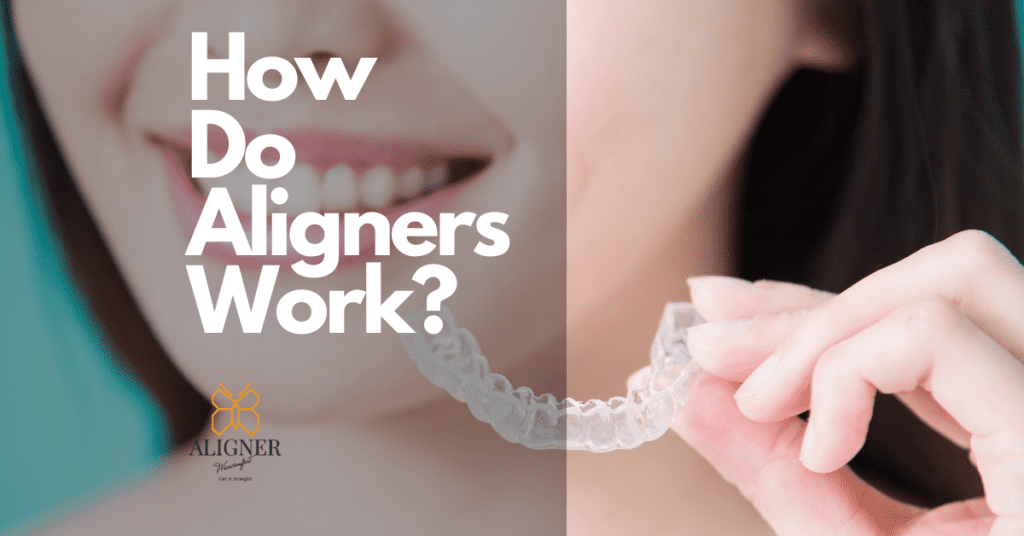How Do Aligners Work in General?
In general, Aligners are used to move teeth in small movements at a time by putting gentle pressure on your teeth so that they are closer to each other and in alignment.
When you take into consideration that our teeth are the toughest portion of our bodies and that they move within our bones, which is the second hardest component, it is really astounding that our teeth can be changed from crooked to straight. And you can accomplish that with only a slender little slice of plastic. What are the odds of that happening? In this piece, we will discuss the operation of aligners as well as the factors that make them a useful alternative to traditional braces.
How does one get their teeth straightened?
There are two components to each of our teeth: the crown, which is the visible portion that has a pearly white color, and the root, which is located underneath the gums. A network of tiny fibers known as the periodontal ligament surrounds the roots of teeth and helps to bind the roots of teeth to the bone that surrounds them. When force is given to a tooth, the ligament transmits that force to the bone, which in turn causes the bone to reconfigure itself in a way that makes it possible for the tooth to move in the direction that was applied. Teeth amazingly respond to extremely light, delicate stresses that are delivered over the course of a period of time.
Braces and clear aligners for teeth both exert pressure on the teeth in a methodical and regulated manner, and tooth movement is a direct outcome of this pressure. And in comparison to braces, aligners are completely undetectable.

Other Options Then Getting Aligner For Your Teeth?
Roughly one hundred years ago, orthodontic braces were first introduced. Despite undergoing a great deal of change and development over the course of their history, their functionality has never changed. Braces are custom-made grips that are affixed to a patient’s teeth, and the wires in the braces function as the guide rails that “instruct” the teeth in their new positions. Although braces are incredibly efficient at straightening teeth, they do come with a number of significant drawbacks: Because braces are prone to breaking, can be painful, can have food stuck in them and are difficult to clean, and require many more office visits for adjustments by an orthodontist, dietary restrictions are necessary for those who wear them.
On the other hand, in comparison to braces, clear aligners are easier to clean, more pleasant to wear, and do not restrict the wearer’s diet in any way, so they can eat whatever they want. In the field of orthodontics, braces have traditionally been considered the gold standard; however, clear aligner technology has made significant advancements over the past 20 years and can now compete with the effectiveness of braces for many orthodontic issues.
How Clear Aligners Work By Straightening Teeth Without Dentist Appointments?
Orthodontists have discovered that some tooth movements are able to be predicted and monitored remotely, which eliminates the need for patients to make frequent trips to their offices to have their teeth straightened. In order to further treatment with braces, periodic wire replacements are required. The “wire changes” are already pre-programmed into the clear aligners that you are provided with, so you don’t need to worry about it. This makes things more convenient for patients without requiring them to give up any control over their care.
Patients who are looking for a teeth straightening alternative that is both simple and economical may find that teledentistry, which is the use of technology to support and provide dental care delivery, has produced this convenience that is highly appealing to them.
When compared to braces, do clear aligners present a more risky treatment option?
Yes. In the event that your teeth are in good health, using transparent aligners to straighten your teeth is a risk-free procedure. Before beginning treatment with clear aligners, patients are encouraged to visit a dentist within the last year for a comprehensive dental exam, teeth cleaning, and x-rays. This ensures that there is no dental decay, gum disease, or other anomalies that could impact the outcome of orthodontic clear aligner treatment as well as the patient’s safety.
The advantages of using clear aligners to straighten one’s teeth
When it comes to straightening teeth, utilising clear aligners rather than metal braces has a number of advantages, including the following:
- When they are no longer required, aligners are simple to remove.
- Aligners made of clear plastic are less prone to irritate the gums and other soft tissues in the mouth.
- As the teeth of the patient advance toward a more desirable alignment, the patient gets the opportunity to show off their smile.
- Offers a method that is unobtrusive to straighten one’s teeth.
The Drawbacks of Aligners
- When dealing with complex difficulties, it is less effective. Although the research conducted by ResearchTrusted Source was limited, it does appear to imply that clear aligner is more beneficial for patients whose teeth only require particular sorts of movement. If your condition is more complicated, your physician might consider trying a different treatment method. In addition, if any of your teeth already have crowns or bridgework attached to them, then aligners may not be the best choice for you.
- Requires compliance. If you want to get the most out of aligners, you need to wear them for at least 20 and preferably 22 hours each day. If you believe that you will be tempted to take them out more frequently, this option probably is not the ideal one for you.
- When eating or drinking, remove the item. You need to remove the aligners before you consume anything by way of food or liquid. If you don’t do it, there’s a chance that food or liquid will get into them. This encourages the growth of bacteria along the gumline and along the teeth, which can eventually result in cavities. Additionally, liquid has the potential to soak down into them, staining both the aligners and your teeth in the process.
Restriction of food intake When the aligner is removed, you can have some discomfort in your teeth, which might make it difficult for you to eat certain foods. Avoid foods that are particularly tough, such as nuts.

Book an appointment
Check to See if They’re Right for You!
When you use clear braces like our Aligner WiseComfort’s aligner to straighten your teeth, you get a lot of benefits. You can straighten your teeth quickly and easily while brushing them, eating, and drinking as usual. You’ll feel better about your teeth and smile as you slowly straighten them without people noticing you are using an appliance because it is almost invisible…!!
It is clear that benefits of invisible braces could help you to achieve your perfect smile with all the 9 advantages provided over traditional metal braces.
Looking to straighten your teeth without pain and not sure which is better options? You can book an appointment online 24/7 or contact us today!



